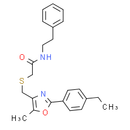Description
iCRT3 is an inhibitor of the Wnt/wingless signaling pathway. iCRT3 efficiently block Wnt/β-catenin-induced target genes and phenotypes in various mammalian and cancer cell lines. Importantly, these Wnt inhibitors are specifically cytotoxic to human colon tumor biopsy cultures as well as colon cancer cell lines that exhibit deregulated Wnt signaling.
Product information
CAS Number: 901751-47-1
Molecular Weight: 394.53
Formula: C23H26N2O2S
Chemical Name: 2-[[[2-(4-ethylphenyl)-5-methyl-4-oxazolyl]methyl]thio]-N-(2-phenylethyl)acetamide
Smiles: CC1OC(=NC=1CSCC(=O)NCCC1C=CC=CC=1)C1C=CC(CC)=CC=1
InChiKey: QTDYVSIBWGVBKU-UHFFFAOYSA-N
InChi: InChI=1S/C23H26N2O2S/c1-3-18-9-11-20(12-10-18)23-25-21(17(2)27-23)15-28-16-22(26)24-14-13-19-7-5-4-6-8-19/h4-12H,3,13-16H2,1-2H3,(H,24,26)
Technical Data
Appearance: Solid Power.
Purity: ≥98% (or refer to the Certificate of Analysis)
Solubility: Soluble in DMSO
Shipping Condition: Shipped under ambient temperature as non-hazardous chemical or refer to Certificate of Analysis
Storage Condition: Dry, dark and -20 oC for 1 year or refer to the Certificate of Analysis.
Shelf Life: ≥12 months if stored properly.
Stock Solution Storage: 0 - 4 oC for 1 month or refer to the Certificate of Analysis.
Drug Formulation: To be determined.
HS Tariff Code: 382200
How to use
In Vitro:
iCRT3 is an inhibitor of both Wnt and β-catenin-responsive transcription. iCRT3 significantly decreases TOP Flash activity and reduces the level of NTSR1. The anti-apoptotic effects of Neurotensin (NTS) and Wnt3a can be largely abrogated by iCRT3. Cells maintained long term with iCRT3 show enhanced expression of classic pluripotency genes compare with the DMSO control, whereas expression of differentiation markers and T-cell factor (TCF) target genes is concomitantly reduced[2]. Treatment with iCRT3 at doses of 12.5, 25, 50, and 75 μM decreases TNF-α levels by 14.7%, 18.5%, 44.9% and 61.3%, respectively. With iCRT3 treatment, IκB levels are increased in a dose-dependent manner compare to the vehicle.
In Vivo:
The tumor growth rates are markedly retarded by iCRT3 treatment. Consistently, the tumor-suppressive role of iCRT3 is accompanied with a reduction in Ki67 index, a proliferation marker. The IL-6 levels in the 10 mg/kg iCRT3 treatment group are 82.9% lower than those in the vehicle group. IL-1β levels are undetectable in the sham but reach 371 pg/mL in septic mice and are down by 30.2% and 53.2%, respectively, with 5 and 10 mg/kg iCRT3. With iCRT3 treatment at doses of 5 and 10 mg/kg, AST levels in these septic mice are 15.4% and 44.2% lower, respectively, than those in the vehicle-treated mice. After treatment with 10 mg/kg iCRT3, lung morphology is improved with much reduced microscopic deterioration, compare to the vehicle group. The number of apoptotic cells in the lung tissues of the iCRT3-treated mice is significantly reduced by 92.7% in comparison with the vehicle group.
References:
- Xiao H, et al. A Novel Positive Feedback Loop Between NTSR1 and Wnt/β-Catenin Contributes to Tumor Growth of Glioblastoma. Cell Physiol Biochem. 2017 Oct 24;43(5):2133-2142.
- Chatterjee SS, et al. Inhibition of β-catenin-TCF1 interaction delays differentiation of mouse embryonic stem cells. J Cell Biol. 2015 Oct 12;211(1):39-51.Sharma A, et al. Mitigation of sepsis-induced inflammatory responses and organ injury through targeting Wnt/β-catenin signaling. doi: 10.1038/s41598-017-08711-6.
Products are for research use only. Not for human use.
Payment & Security
Your payment information is processed securely. We do not store credit card details nor have access to your credit card information.


